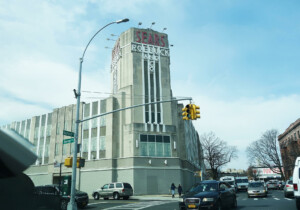From the eastern facade of the outwardly nondescript Chicago Loop Synagogue, an elaborate stained-glass wall filters blue, red, and gold light into an open sanctuary. Specially designed over the course of two years by New York-based artist Abraham Rattner, the monumental, 40-foot-wide piece of art was fabricated in the Paris studio of the prolific stained-glass artist Jean Barillet during the 1970s. Its expressive abstract forms and religious motifs take cues from the opening lines of the Hebrew Bible’s Book of Genesis—namely, “and there was light.”
To the dismay of the institution’s leaders, though, the light at the end of the congregation’s tunnel may now be fading. Established in 1929 in the city’s central business district, the Chicago Loop Synagogue has primarily served office workers for much of its history. Its regular weekday services and kosher food offerings provided a consistent venue for worship, attracting Jewish commuters from other parts of the metropolitan area, as well as business travelers from as far away as New York and Los Angeles.
According to the Jewish Telegraphic Agency, the Chicago Loop Synagogue’s membership has shrunk markedly in the last thirty years, a trend that began long before the onset of COVID-19 shutdowns. Its congregation, now just over 400 strong, has only about 30-to-40 members who live in the vicinity and attend Saturday services. With such small numbers, the relatively affordable dues of $180 or less per year do not generate enough revenue to maintain current operations. Lee Zoldan, the president of the congregation, estimated that the institution’s cash assets can only keep it afloat for another 18 months.
With the synagogue in serious jeopardy of losing its space in the Loop, the future of its distinct stained glass panels is in question. Insured for $1.5 million and purpose-built for the space, Rattner’s three-story windows are unlikely to fit in any other setting. Moving the Chicago Loop Synagogue to a smaller or more affordable venue, then, would put the building and its glass at risk of demolition.
A task force convened by Zoldan to determine the best paths forward has proposed two promising ideas for the future of the synagogue. The first is to invite another tenant to co-locate within the building. Ideally, an event space or theater would introduce critical new revenue streams while enabling the Chicago Loop Synagogue to continue providing daytime worship services.
The other idea, supported by architect and task force member Michael Landau, is to establish a sanctuary for stained-glass windows from dissolving synagogues across the country. Under this model, the Chicago Loop Synagogue would become a museum and safe haven of sorts, ensuring that such unique pieces of art are preserved and displayed for future generations.
No matter the outcome, Zoldan and other congregants hope that the organization can continue to use its historic and unique home—a building inextricable from the identity of the synagogue itself.











